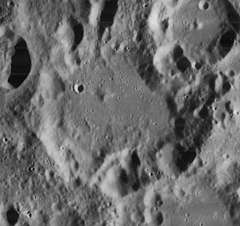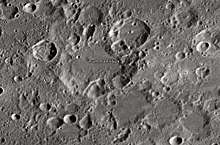Gemma Frisius (crater)
Gemma Frisius is a lunar impact crater that is located in the rugged southern highlands of the Moon. It was named after Dutch physician Gemma Frisius.[1] It lies to the north of the walled plain Maurolycus, and southeast of the smaller crater Poisson. The crater Goodacre is attached to the northeast rim.
 | |
| Coordinates | 34.2°S 13.3°E |
|---|---|
| Diameter | 88 km |
| Depth | 4.7 km |
| Colongitude | 347° at sunrise |
| Eponym | Gemma Frisius |
The outer wall of this crater has been heavily damaged by impacts, particularly along the north and west sides. The smaller satellite craters D, G, and H are attached to this damaged crater. As some observers have noted, this crater formation bears a certain resemblance to a paw print with these craters forming three of the toes and the crater Goodacre the fourth.
The southeastern rim of the crater is also worn, and the inner wall has slumped nearly a third of the distance across the interior floor. The remainder of the floor is relatively level and deep, with a central peak that is offset to the northwest of the midpoint.
Satellite craters

By convention these features are identified on lunar maps by placing the letter on the side of the crater midpoint that is closest to Gemma Frisius.
| Gemma Frisius |
Latitude | Longitude | Diameter |
|---|---|---|---|
| A | 35.8° S | 15.2° E | 68 km |
| B | 35.5° S | 17.1° E | 41 km |
| C | 35.6° S | 18.8° E | 35 km |
| D | 34.3° S | 10.9° E | 28 km |
| E | 37.2° S | 12.8° E | 19 km |
| F | 35.8° S | 10.3° E | 9 km |
| G | 33.2° S | 11.4° E | 37 km |
| H | 32.4° S | 12.2° E | 28 km |
| J | 35.1° S | 18.1° E | 12 km |
| K | 37.4° S | 11.0° E | 10 km |
| L | 34.8° S | 11.8° E | 6 km |
| M | 34.3° S | 12.5° E | 5 km |
| O | 32.5° S | 12.9° E | 6 km |
| P | 31.8° S | 12.8° E | 4 km |
| Q | 35.8° S | 14.8° E | 9 km |
| R | 37.1° S | 15.3° E | 5 km |
| S | 35.2° S | 15.1° E | 6 km |
| T | 34.9° S | 16.4° E | 8 km |
| U | 34.5° S | 16.8° E | 8 km |
| W | 36.9° S | 13.3° E | 15 km |
| X | 34.7° S | 15.8° E | 15 km |
| Y | 37.4° S | 13.5° E | 28 km |
| Z | 35.1° S | 9.6° E | 10 km |
References
| Wikimedia Commons has media related to Gemma Frisius (crater). |
- "Gemma Frisius (crater)". Gazetteer of Planetary Nomenclature. USGS Astrogeology Research Program.
- Andersson, L. E.; Whitaker, E. A. (1982). NASA Catalogue of Lunar Nomenclature. NASA RP-1097.CS1 maint: ref=harv (link)
- Bussey, B.; Spudis, P. (2004). The Clementine Atlas of the Moon. New York: Cambridge University Press. ISBN 978-0-521-81528-4.CS1 maint: ref=harv (link)
- Cocks, Elijah E.; Cocks, Josiah C. (1995). Who's Who on the Moon: A Biographical Dictionary of Lunar Nomenclature. Tudor Publishers. ISBN 978-0-936389-27-1.CS1 maint: ref=harv (link)
- McDowell, Jonathan (July 15, 2007). "Lunar Nomenclature". Jonathan's Space Report. Retrieved 2007-10-24.CS1 maint: ref=harv (link)
- Menzel, D. H.; Minnaert, M.; Levin, B.; Dollfus, A.; Bell, B. (1971). "Report on Lunar Nomenclature by the Working Group of Commission 17 of the IAU". Space Science Reviews. 12 (2): 136–186. Bibcode:1971SSRv...12..136M. doi:10.1007/BF00171763.CS1 maint: ref=harv (link)
- Moore, Patrick (2001). On the Moon. Sterling Publishing Co. ISBN 978-0-304-35469-6.CS1 maint: ref=harv (link)
- Price, Fred W. (1988). The Moon Observer's Handbook. Cambridge University Press. ISBN 978-0-521-33500-3.CS1 maint: ref=harv (link)
- Rükl, Antonín (1990). Atlas of the Moon. Kalmbach Books. ISBN 978-0-913135-17-4.CS1 maint: ref=harv (link)
- Webb, Rev. T. W. (1962). Celestial Objects for Common Telescopes (6th revised ed.). Dover. ISBN 978-0-486-20917-3.CS1 maint: ref=harv (link)
- Whitaker, Ewen A. (1999). Mapping and Naming the Moon. Cambridge University Press. ISBN 978-0-521-62248-6.CS1 maint: ref=harv (link)
- Wlasuk, Peter T. (2000). Observing the Moon. Springer. ISBN 978-1-85233-193-1.CS1 maint: ref=harv (link)